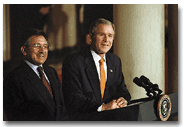Cotton Incorporated, Cary, N.C., has named
Mac McLean
associate director, nonwovens research and implementation.
F. Schumacher & Co., New York City, has named
Dale Williams
president of the Waverly Lifestyle Group. Williams now heads all aspects of the group,
including creative development, finance, sales, and marketing and licensing.

Dale Williams
Fred Whitaker Co., Roanoke, Va., has named
Lewis A. Oechslin Jr.
president and CEO.
Russell Corp., Atlanta, will consolidate the dyeing and finishing facilities at
its textile operations in Alexander City, Ala., under one management team.
Phillip Young
has been promoted to vice president of employee relations.
Doug McBurney
, director of textile operations for Russell Athletic, will also oversee textile
operations for Jerzees. Additional appointments include:
Alan Luker
, technical manager;
Sam Leonard
, production manager for bleachery operations; and
Jim Ed Abernathy
, production manager for Plant #7 annex.
Bill Parks
will move into a technical role within the organization. Luker, Leonard, Abernathy and
Parks will report to
Wade Price
, plant manager for the consolidated operation.
The Carpet Cushion Council (CCC), Riverside, Conn., has elected the following
executive board members:
Charles Mussallem III
, president;
Terry Kall
, secretary; and
Robert Heller
, treasurer.
William H. “Bill” Oler
continues as executive director of programs and activities.
WestPoint Stevens, West Point, Ga., has appointed President and COO
M.L. “Chip” Fontenot
to fill a vacancy on the company’s Board of Directors.
Air Products and Chemicals Inc., Allentown, Pa., has named
Bernard Guerini
president, Air Products Europe. Guerini replaces
Ron Sullam
, who retired.
John (Mike) McNallen
replaces Guerini as vice president, North America Gases. In addition,
William Koch
is the new global director, Process Safety Integrity.
Thantex Specialties Inc., Arden, N.C., has announced the following appointments to
its management team:
Jeff Bennett
, president;
Larry Zenick
, operations manager;
Robert Vance
, maintenance director;
Jimmy King
, sales manager;
Larry Creizman
, by-products sales manager; and
Feng Qin
, product development manager.
Optimer Performance Fibers, Wilmington, Del., has named
Whit Raymond
business development associate for the running and multisport markets.

Raymond
Veit GmbH & Co., Germany, has appointed
Patrick Kugler
project manager for technical sales, and
Gerhard Birzer
sales manager for the garment technology sector.
Stephen J. Dauer
has joined
Scott Mills, Gastonia, N.C., a division of Kleinert’s Inc., as executive vice
president of sales and marketing.
The
Georgia Institute of Technology, Atlanta, has named
Don P. Giddens
dean of the College of Engineering.

Giddens
eWarna, New York City, has appointed
Malcolm Ball
European director.
Michael Dworak
has joined Milwaukee-based
Teklynx International as global customer care process manager.
The
Screenprinting & Graphic Imaging Association (SGIA) and
Digital Printing & Imaging Association (DPI), both based in Fairfax, Va., have
named
Michael Robertson
president.
The
National Cotton Council (NCC), Memphis, Tenn., has elected
Kenneth Hood
to the top position of council chairman.
The
American Flock Association (AFA), Boston, has appointed
Barrett F. Ripley Keene
executive director of the association.
Spartanburg-based
Symtech Inc. has named
Christian Roedlich
product manager.
Honeywell, Morristown, N.J., has elected
David M. Cote
president, CEO and member of the board. Cote succeeds
Lawrence A. Bossidy
, who remains chairman and member of the board until his retirement in June.
April 2002


 O
O





